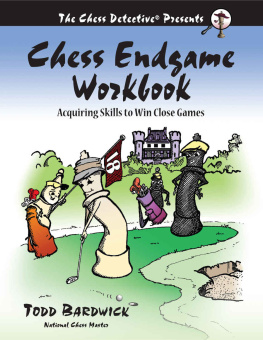Liquidation on the Chess Board Joel BenjaminLiquidation on the Chess BoardMastering the Transition into the Pawn Ending2015 New In Chess 2015 New In Chess Published by New In Chess, Alkmaar, The Netherlands www.newinchess.com All rights reserved. No part of this book may be reproduced, stored in a retrieval system or transmitted in any form or by any means, electronic, mechanical, photocopying, recording or otherwise, without the prior written permission from the publisher. All photos: New In Chess Archives, unless indicated otherwise. Cover design: Volken Beck Supervisor: Peter Boel Proofreading: Ren Olthof Production: Anton Schermer Have you found any errors in this book? Please send your remarks to and implement them in a possible next edition. ISBN: 978-90-5691-553-7 Explanation of SymbolsThe chessboard with its coordinates:
 | White to move |
 | Black to move |
| K | King |
| Q | Queen |
| R | Rook |
| B | Bishop |
| N | Knight |
| +/= | White stands slightly better |
| =/+ | Black stands slightly better |
| +/ | White stands better |
| -/+ | Black stands better |
| + | White has a decisive advantage |
| + | Black has a decisive advantage |
| = | balanced position |
| ! | good move |
| !! | excellent move |
| ? | bad move |
| ?? | blunder |
| !? | interesting move |
| ?! | dubious move |
| --> | attack |
| # | mate |
| corr. | correspondence |
Acknowledgements Thank you to the New In Chess editorial staff, particularly Peter Boel and Ren Olthof, who provided a lot of useful suggestions for fine tuning the manuscript.
I would like to extend my appreciation to Alex Baburin for his work in his online newspaper Chess Today. After seeing some fascinating pawn endings appear in CTs Endgame Kaleidoscope I was inspired to flesh out his excellent analysis and seek out more endgames, which led to the production of this book. I would also like to thank my students, John Michael Burke and Praveen Balakrishnan, for providing games for the book. I used the chess engine Fritz 13 (with some help from Rybka 2.3.2a 32-bit) and the online Shredder endgame database. Chess engines have grown tremendously in strength to the point where all works of analysis rely heavily on their input. Fritzy uncovered a host of hidden possibilities missed by players, analysts, and myself. These discoveries made the book a whole lot richer.
Readers, however, should be aware of the limitations chess engines have in the endgame. Fritz 13 was adept at finding conclusive continuations forced Zugzwangs, pawn breakthroughs, and the like. But in positions where the key question is how to make progress, it often faltered, producing winning evaluations without any apparent winning plan. Players should be especially conscious of that when scrutinizing their own games. Endgame tablebases provide a true assessment for all positions with six or fewer pieces. All such positions in this book thus have that extra quality assurance.
Tablebases are most often cited here in queen & pawn v. queen endings, partly because proper play in such endings is difficult to explain as well as lengthy and beyond the scope of the agenda here. As I have said in the chapters, tablebase wins and draws are very difficult to execute properly for humans. In the pure pawn endings, tablebase analysis is quite enlightening and understandable, though most of these positions have been worked out by humans. Finally, I would like to dedicate this book to past and potentially future Olympians, my wife Deborah and my children Aidan and Amy. Joel Benjamin,Waldwick NJ, December 2014PrologueThe ABCs of Chess I was playing my first games as a grandmaster in Jerusalem 1986, which coincided with the FIDE Congress in Dubai.
The venerable Viktor Kortchnoi had been gradually outplaying me, and I felt the game slipping away in the following position: Joel BenjaminViktor Kortchnoi Jerusalem 1986  47Rb1 This move gave me a bad feeling. Black can also win with 47Rc1 48.Rc6+ (48.Rxa2 Rc2+ ) 48Kb2 49.Rb6+ Ka1 50.Kd2 (or 50.Rxf6 Rc2+ 51.Kd1 Kb1 ) 50Rb1 51.Rxf6 Kb2 52.Rb6+ Ka3 53.Ra6+ Kb3 54.Rb6+ Kc4, etc. But Kortchnoi forced the pawn ending right away, obviously seeing it all to the end. 48.Rxa2 Rb2+ 49.Rxb2 Kxb2 Even though the black king seems to be far from the action, White is lost! 50.f3 White cant do without this move, for example, 50.Kd2 Kb3 51.Kd3 Kb4 52.Kd2 Kc4 53.Ke3 Kc3 54.Ke2 Kd4 clips the e4-pawn. 50Kc3! Chess is not checkers you dont have to take. 51.fxg4 Kd4 52.Kf3 Kd3 53.Kf2 Kxe4 54.Ke2 Kd4 55.Kd2 e4 56.Ke2 e3 The game was adjourned here (remember adjournments, anyone?) and I sealed 57.Kd1 I would obviously lose after 57.Ke1 Kd3 58.Kd1 e2+ 59.Ke1 Ke3 (I like to call this motif the fake stalemate White has to move pawns against his will) 60.g5 fxg5 61.g4 Kf3. 51.fxg4 Kd4 52.Kf3 Kd3 53.Kf2 Kxe4 54.Ke2 Kd4 55.Kd2 e4 56.Ke2 e3 The game was adjourned here (remember adjournments, anyone?) and I sealed 57.Kd1 I would obviously lose after 57.Ke1 Kd3 58.Kd1 e2+ 59.Ke1 Ke3 (I like to call this motif the fake stalemate White has to move pawns against his will) 60.g5 fxg5 61.g4 Kf3.
47Rb1 This move gave me a bad feeling. Black can also win with 47Rc1 48.Rc6+ (48.Rxa2 Rc2+ ) 48Kb2 49.Rb6+ Ka1 50.Kd2 (or 50.Rxf6 Rc2+ 51.Kd1 Kb1 ) 50Rb1 51.Rxf6 Kb2 52.Rb6+ Ka3 53.Ra6+ Kb3 54.Rb6+ Kc4, etc. But Kortchnoi forced the pawn ending right away, obviously seeing it all to the end. 48.Rxa2 Rb2+ 49.Rxb2 Kxb2 Even though the black king seems to be far from the action, White is lost! 50.f3 White cant do without this move, for example, 50.Kd2 Kb3 51.Kd3 Kb4 52.Kd2 Kc4 53.Ke3 Kc3 54.Ke2 Kd4 clips the e4-pawn. 50Kc3! Chess is not checkers you dont have to take. 51.fxg4 Kd4 52.Kf3 Kd3 53.Kf2 Kxe4 54.Ke2 Kd4 55.Kd2 e4 56.Ke2 e3 The game was adjourned here (remember adjournments, anyone?) and I sealed 57.Kd1 I would obviously lose after 57.Ke1 Kd3 58.Kd1 e2+ 59.Ke1 Ke3 (I like to call this motif the fake stalemate White has to move pawns against his will) 60.g5 fxg5 61.g4 Kf3. 51.fxg4 Kd4 52.Kf3 Kd3 53.Kf2 Kxe4 54.Ke2 Kd4 55.Kd2 e4 56.Ke2 e3 The game was adjourned here (remember adjournments, anyone?) and I sealed 57.Kd1 I would obviously lose after 57.Ke1 Kd3 58.Kd1 e2+ 59.Ke1 Ke3 (I like to call this motif the fake stalemate White has to move pawns against his will) 60.g5 fxg5 61.g4 Kf3.
But now I seemed to hold: 57Kd3 58.Ke1 e2 59.g5 fxg5 60.g4 Ke3 leads to a real stalemate, while 60Ke4 61.Kxe2 Kf4 62.Kf2 Kxg4 63.Kg2 gains White the opposition and draws. I knew this couldnt be correct. Kortchnoi had played too quickly and confidently and the position didnt look like it should be a draw. Before leaving the table, Kortchnoi looked at me and said, I know something about triangles. I was lost in more ways than one, because I still didnt see the win. he grew up in the Soviet Union) showed me the potential finale.  Indeed, it is all about triangles: 57Kd5! 58.Ke1 Ke5! 59.Kd1 (59.Ke2 Ke4 puts White in Zugzwang; the king can go to e2 only if Blacks king is already on e4) 59Kd4 and having created the position with White to move, Black wins easily after 60.Ke1 Kd3.
Indeed, it is all about triangles: 57Kd5! 58.Ke1 Ke5! 59.Kd1 (59.Ke2 Ke4 puts White in Zugzwang; the king can go to e2 only if Blacks king is already on e4) 59Kd4 and having created the position with White to move, Black wins easily after 60.Ke1 Kd3.  Indeed, it is all about triangles: 57Kd5! 58.Ke1 Ke5! 59.Kd1 (59.Ke2 Ke4 puts White in Zugzwang; the king can go to e2 only if Blacks king is already on e4) 59Kd4 and having created the position with White to move, Black wins easily after 60.Ke1 Kd3.
Indeed, it is all about triangles: 57Kd5! 58.Ke1 Ke5! 59.Kd1 (59.Ke2 Ke4 puts White in Zugzwang; the king can go to e2 only if Blacks king is already on e4) 59Kd4 and having created the position with White to move, Black wins easily after 60.Ke1 Kd3.
Very pretty, but quite simple, too. I ran after Kortchnoi and resigned, apologizing profusely for my ignorance. Quite perplexed, Kortchnoi told me, It is the ABCs of chess! Of course he was right. Triangulation is a basic technique in pawn endings, which are the building blocks for all other endgames. I realized how important it is to understand pawn endings, and Ive been fascinated by them ever since. 
Next page




















 47Rb1 This move gave me a bad feeling. Black can also win with 47Rc1 48.Rc6+ (48.Rxa2 Rc2+ ) 48Kb2 49.Rb6+ Ka1 50.Kd2 (or 50.Rxf6 Rc2+ 51.Kd1 Kb1 ) 50Rb1 51.Rxf6 Kb2 52.Rb6+ Ka3 53.Ra6+ Kb3 54.Rb6+ Kc4, etc. But Kortchnoi forced the pawn ending right away, obviously seeing it all to the end. 48.Rxa2 Rb2+ 49.Rxb2 Kxb2 Even though the black king seems to be far from the action, White is lost! 50.f3 White cant do without this move, for example, 50.Kd2 Kb3 51.Kd3 Kb4 52.Kd2 Kc4 53.Ke3 Kc3 54.Ke2 Kd4 clips the e4-pawn. 50Kc3! Chess is not checkers you dont have to take. 51.fxg4 Kd4 52.Kf3 Kd3 53.Kf2 Kxe4 54.Ke2 Kd4 55.Kd2 e4 56.Ke2 e3 The game was adjourned here (remember adjournments, anyone?) and I sealed 57.Kd1 I would obviously lose after 57.Ke1 Kd3 58.Kd1 e2+ 59.Ke1 Ke3 (I like to call this motif the fake stalemate White has to move pawns against his will) 60.g5 fxg5 61.g4 Kf3. 51.fxg4 Kd4 52.Kf3 Kd3 53.Kf2 Kxe4 54.Ke2 Kd4 55.Kd2 e4 56.Ke2 e3 The game was adjourned here (remember adjournments, anyone?) and I sealed 57.Kd1 I would obviously lose after 57.Ke1 Kd3 58.Kd1 e2+ 59.Ke1 Ke3 (I like to call this motif the fake stalemate White has to move pawns against his will) 60.g5 fxg5 61.g4 Kf3.
47Rb1 This move gave me a bad feeling. Black can also win with 47Rc1 48.Rc6+ (48.Rxa2 Rc2+ ) 48Kb2 49.Rb6+ Ka1 50.Kd2 (or 50.Rxf6 Rc2+ 51.Kd1 Kb1 ) 50Rb1 51.Rxf6 Kb2 52.Rb6+ Ka3 53.Ra6+ Kb3 54.Rb6+ Kc4, etc. But Kortchnoi forced the pawn ending right away, obviously seeing it all to the end. 48.Rxa2 Rb2+ 49.Rxb2 Kxb2 Even though the black king seems to be far from the action, White is lost! 50.f3 White cant do without this move, for example, 50.Kd2 Kb3 51.Kd3 Kb4 52.Kd2 Kc4 53.Ke3 Kc3 54.Ke2 Kd4 clips the e4-pawn. 50Kc3! Chess is not checkers you dont have to take. 51.fxg4 Kd4 52.Kf3 Kd3 53.Kf2 Kxe4 54.Ke2 Kd4 55.Kd2 e4 56.Ke2 e3 The game was adjourned here (remember adjournments, anyone?) and I sealed 57.Kd1 I would obviously lose after 57.Ke1 Kd3 58.Kd1 e2+ 59.Ke1 Ke3 (I like to call this motif the fake stalemate White has to move pawns against his will) 60.g5 fxg5 61.g4 Kf3. 51.fxg4 Kd4 52.Kf3 Kd3 53.Kf2 Kxe4 54.Ke2 Kd4 55.Kd2 e4 56.Ke2 e3 The game was adjourned here (remember adjournments, anyone?) and I sealed 57.Kd1 I would obviously lose after 57.Ke1 Kd3 58.Kd1 e2+ 59.Ke1 Ke3 (I like to call this motif the fake stalemate White has to move pawns against his will) 60.g5 fxg5 61.g4 Kf3. Indeed, it is all about triangles: 57Kd5! 58.Ke1 Ke5! 59.Kd1 (59.Ke2 Ke4 puts White in Zugzwang; the king can go to e2 only if Blacks king is already on e4) 59Kd4 and having created the position with White to move, Black wins easily after 60.Ke1 Kd3.
Indeed, it is all about triangles: 57Kd5! 58.Ke1 Ke5! 59.Kd1 (59.Ke2 Ke4 puts White in Zugzwang; the king can go to e2 only if Blacks king is already on e4) 59Kd4 and having created the position with White to move, Black wins easily after 60.Ke1 Kd3. 